By Ashley Smith
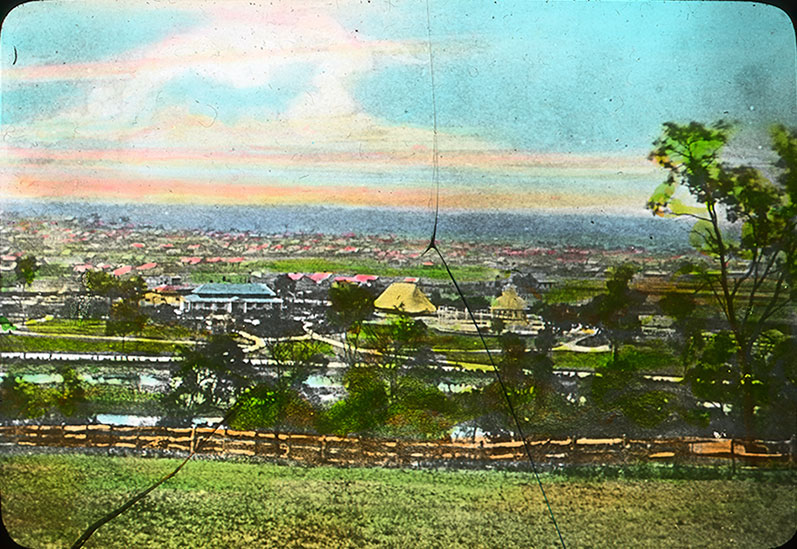
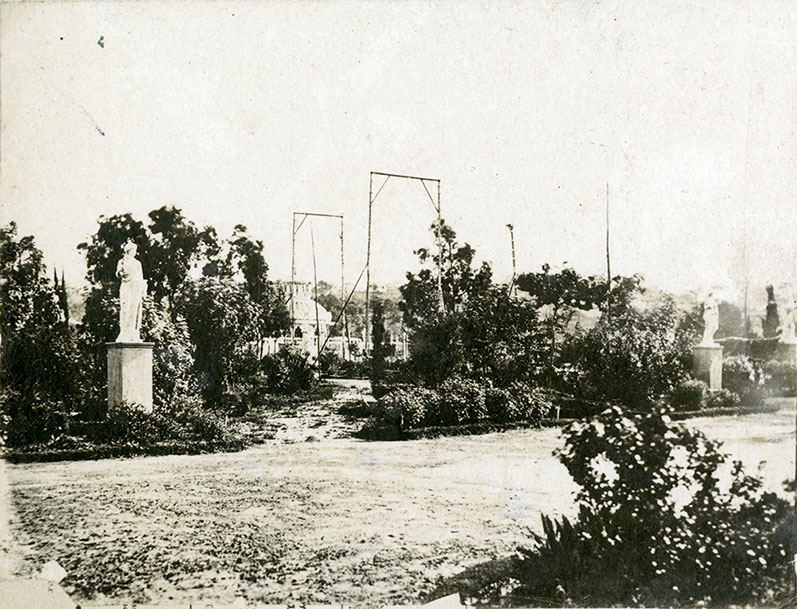
(Left: coloured picture slide of the Gardens, supposedly from East of the river. Right: Statues and plant life at Cremorne. Source: RHSV GS-EM-14 / S-182.001)
THE GARDENS.
Just a short walk from Richmond Station, past the small terrace houses and factories, you’ll find a small park known as the Charles Evans Reserve. It is separated from the Monash Freeway by a high fence. If you are observant enough, you will find a plaque which declares:
“CREMORNE GARDENS RICHMOND
Near to this spot on Monday 12 th December 1853,
James Ellis opened the Cremorne Gardens,
Richmond’s renowned pleasure gardens.
Unveiled by Commissioner Alex G. Gillon O.B.E. J.P.
Commissioner, City of Richmond,
29th April 1984.
Cremorne Gardens Residents Action Group.”
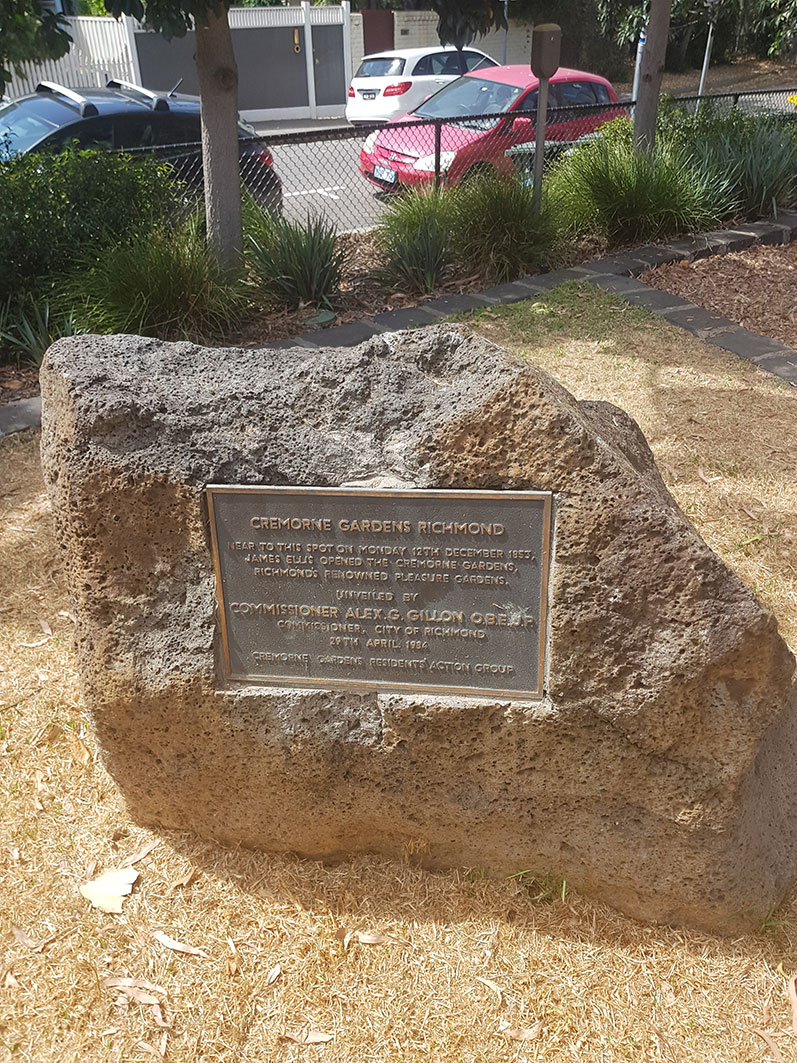
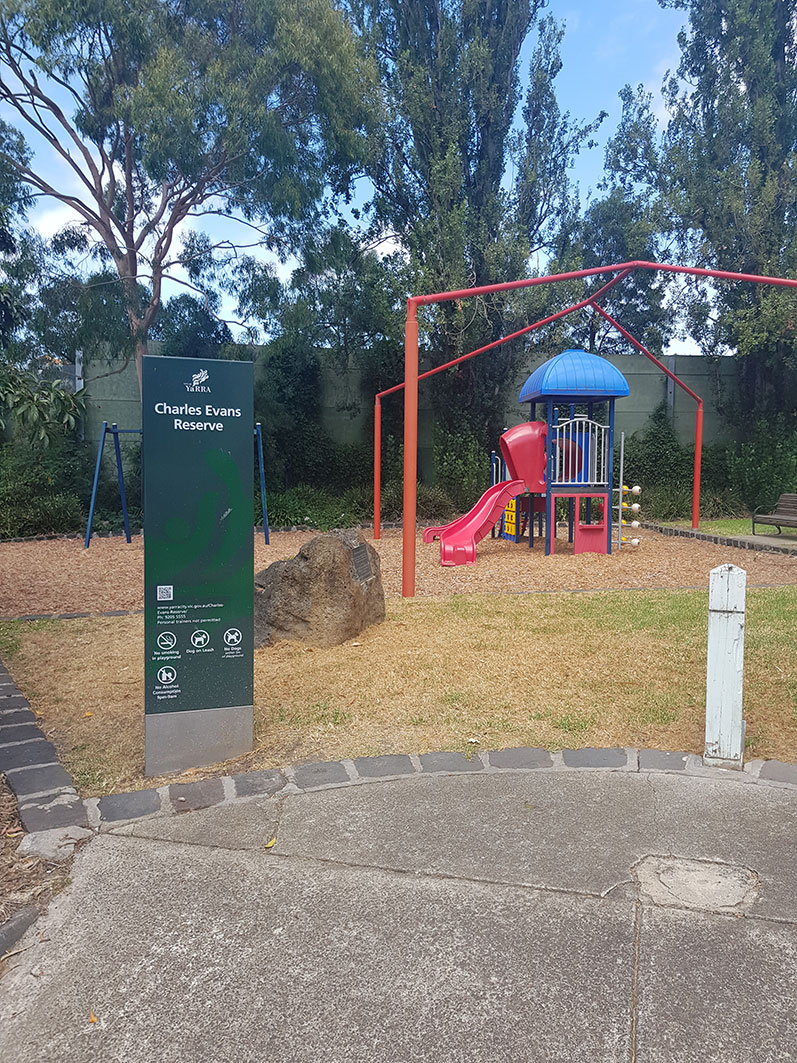
(Pictured: Plaque and its current site at Charles Evans Reserve. Source: Author.)
Unfortunately, this tribute is the only indicator that the Park was once part of a site that provided hours of leisure for Melburnians in the 19th century.
The Garden’s origins stem back to mid-19th century England. During this period, pleasure gardens were the amusement parks of their time. Whilst not as ride-heavy as their successors, they offered the public a variety of recreational and leisurely activities, such as concert halls, zoos, menageries and rides. In the 1830’s, a London property owned by the First Viscount of Cremorne was sold to Baron de Berenger (in reality, a fraudster named Charles Random), who established a “National Sporting Club” (known as The Stadium) there. It was then acquired by coffee house owner Thomas Bartlett Simpson, who sublet the property to confectioner James Ellis. Under Ellis, the Gardens were re-opened as the Cremorne Gardens in 1845, and during its run featured restaurants, balloon ascents, and areas for dancing and entertainment. Whilst Ellis was eventually forced to relinquish the manager role due to bankruptcy, the London incarnation of the Gardens continued to stay open under various managers until 1877.
Ellis migrated to Melbourne in 1852, just as the Gold Rush was tempting many a traveller to change their fortunes. Whilst he did not strike it rich, he spent time setting up dancing rooms at the corner of Bourke and Spring Streets (later known as Salle de Valentino), before buying 10 acres of land near the Yarra River. Consisting of a small billabong known as Wrights Swamp, the land had previously been owned by architect Henry Gin.
Soon, Ellis went to work creating a new pleasure garden. Before the official opening, people were given a sneak peek at what to expect. The Argus on October 29th 1853 reported the place was open “for promenade and refreshments daily” and mentioned the Garden’s horse-shoe shape, with the land sloping “towards a lagoon, which lies between the gardens and the river”. There were also a variety of trees (ash, oak, poplar), a statue of Eve being prepared for a grotto, and a pagoda being brought from New York.
The Gardens officially opened on December 10th 1853, with the money raised on that first day going to the left wing construction of the Melbourne Hospital. However, it was not the success Ellis may have hoped for. The Argus on December 12th reported that the first night attendance “of pleasure seekers who assembled to amuse themselves was more select than numerous and the gardens were far from being overcrowded”. This was despite reportedly having more amusements than its English counterpart.
Under the management of Ellis, the Gardens had numerous attractions. For an admission price between a shilling and half-a-crown (2 shillings and sixpence), visitors were treated to a variety of entertainments. They could dance at the dancefloor, be carried up a contraption known as a Swiss staircase (where people were pulled up a staircase by basket and pulley), and watch tightrope walkers and fireworks displays along the swamp. With public transport limited, a specialised paddle steamer known as the Gondola would leave Princes Bridge and drop visitors off at Cremorne. A fee had to be paid, but it was better than the alternative: walking the distance from Melbourne, where violent larrikins were likely to strike.
Ellis was also met with problems from the law. In particular, due to the licencing laws of the time, he found himself prosecuted for not serving alcohol to travellers on Sundays, despite laws only allowing for the sale of alcohol between 1-3pm. Ellis tried to protest the prohibition law to Lieutenant-Governor Hotham, citing the Gardens had to be open on Sundays as it was the best opportunity for workers to visit. However, Hotham would ignore his pleas. These unusual restrictions may seem like strange practice, but what has to be considered that this was during a time where concerned individuals put up petitions on liquor laws, believing alcohol was the cause of immorality and crime.
The struggle of maintaining the Gardens forced Ellis to lease it in December 1855, and he moved on to become a hotel tenant. Meanwhile, the new proprietor, W.P. Scott, added a panoramic picture model to the Gardens. Reportedly requiring about 18,000 feet of canvas, the model would highlight topical events to a populace who were otherwise isolated from the rest of the world, including the 1854 Seige of Sebastapol (a crucial battle of the Crimean War). Scott would also see the Gardens become the location of a special celebration as it hosted the first 8 hours movement fete to celebrate the first procession of the 8 hours movement on May 12th 1856. That day, 1500 men marched from Carlton Gardens to partake in the fete, with 248 pounds raised and donated to the Melbourne Hospital and Benevolent Asylum.
The site was then taken over by theatrical actor/manager George Coppin and his friend, actor Gustavus Vaughan Brooke (1818-1866). Coppin was already the owner of multiple theatres (including the Olympic and the Princess), and appeared passionate in putting everything he had to give the best quality entertainment possible. Spending 10,000 pounds on its renovation, by the time the site re-opened on October 1856 there were a number of additions. There was now a maze, a bowling saloon, a rifle gallery and a menagerie of birds and animals. An open-aired theatre known as the Pantheon would present many stage performances and concerts (some starring Coppin himself), and had a built-in balcony that allowed the audience to see the fireworks displays.
Fireworks displays were a popular highlight, allied with a model re-enactment of the eruption of Mt Vesuvius, complete with ‘lava’ oozing from the volcano. Later models would also expose viewers to events happening far away, whether it was the opium wars in China (1858’s Battle of Canton display) or the Sepoy Rebellion (1859’s display on the Fall of Dehli). Needless to say, these models were likely more spectacular at night than at day as British writer Louisa Ann Meredith once described them as “ungainly fabric of canvas and scaffolding”.
Throughout his time as manager, Coppin tried numerous things to make sure many would enter through the gates. In 1859, a railway station was built to the east of the Gardens, giving visitors easier (and safer) access to the site. New, exotic animals were placed in the menagerie, including lions and swans, as well as camels that were later used for the Burke and Wills expedition. At least 150 statues of plaster and cement that resembled “the most celebrated works of modern and ancient times” were erected, hoping to turn the Gardens into “an instructive Rendezvous”. Gas lighting was used to illuminate the Gardens at night (despite a reporter for the Bells Life complaining of the smell). Anything from sideshow acts to waxworks exhibitions were presented to a curious public.
One time, visitors were given tickets for a raffle with prizes being as large as 1000 pounds. Pioneer and politician John Pascoe Fawkner threatened to bring this undone when he questioned the legality of this scheme. However, after the prizemoney was (temporarily) reduced by half to cover the ticket costs, the lottery was given the go-ahead and the winning numbers were published. Cremorne was also the host of many events for the community, whether it was fairs, the 8 hour day celebrations, or an 1859 exhibition of the Victorian Industrial Society, which showcased the best in furniture, crockery and fine arts.
Most famously, the Gardens were the sight of the first ever balloon flight in Australia on February 1 st 1858. Whilst looking for new talent in Britain, Coppin invited balloonists Charles Brown and Joseph Dean to demonstrate this feat. The balloon known as The Australasian had been partially filled at the Melbourne Gasworks the night before, and then was carted to the Gardens and filled at its own gasometer. Unfortunately, a leak on the balloon meant that only one man would go up. As history records, it was Dean who flew The Australasian for 25 minutes before landing in Heidelberg. However, any monetary gain Coppin tried to get from the event backfired, with the rise in admission prices (to 5 shillings) for the event prompting many to watch the flight from outside the grounds. Several more flights were staged at the Gardens, but with diminishing returns. By the last flight done in 1859, Brown recorded that only 8 people were witness.
Despite the Gardens holding as many as 5000 people on a busy day, the site was eventually closed in 1863. The reasons for its failures are multiple. The large scale of maintenance costs would often eat into the profits. Weather and distance would always be a factor, especially if it rained, with the lack of indoor entertainments discouraging many from visiting. It did not help that the Gardens were known for all kinds of people to mingle, especially prostitutes, with areas such as the dancefloor being popular hotspots for romantic trysts. Politician Richard Heales once proclaimed in 1859 that the site was “one of the most frightful causes of prostitution in the colony”. It was perhaps not helped that also in 1859, Coppin had severed his business relationship with Brooke, with both splitting ownership of their theatres. The lack of income from George’s other projects (and the costs of the recently built Haymarket Theatre) would force him to sell Cremorne at auction.
Afterwards, the Gardens were in the ownership of a Mr J.H. Harcourt, who used the Gardens as an asylum. During this period, the lake was drained, and many buildings were converted into different uses (with the billiard room converted into a ‘place of worship’). By 1885, it was subdivided with the first allotment sales made, and virtually all traces of the Gardens existence were removed in the decades that followed. The statues were moved to the Fitzroy Gardens, and became heavily distorted and damaged by multiple re-paints, before their removal in the 1930s.
THE MAN.
BOX 128-14, MS000353, Miscellaneous Papers: George Selth Coppin.

This letter, dated 15 th February 1883, is written by a man who was at the time up for election for the Victorian Legislative Assembly after a 6 year hiatus. In the letter (addressed to an anonymous person), he claims that “…if returned, I shall consider it my duty to support any honest government with administrative ability- that will adopt a national, liberal and progressive policy”. He goes on to regret being unable to visit the recipient due to “lameness”- likely referring to either illness or the gout that plagued his later years.
8 days later that man, George Selth Coppin, was elected back into the Legislative Assembly, a role he continued to serve until 1889. He later would serve the Legislative Council until 1895. However, this letter does not tell the entire story of a man who will be more known to historians as an influential entertainer in both Victoria and Australia.
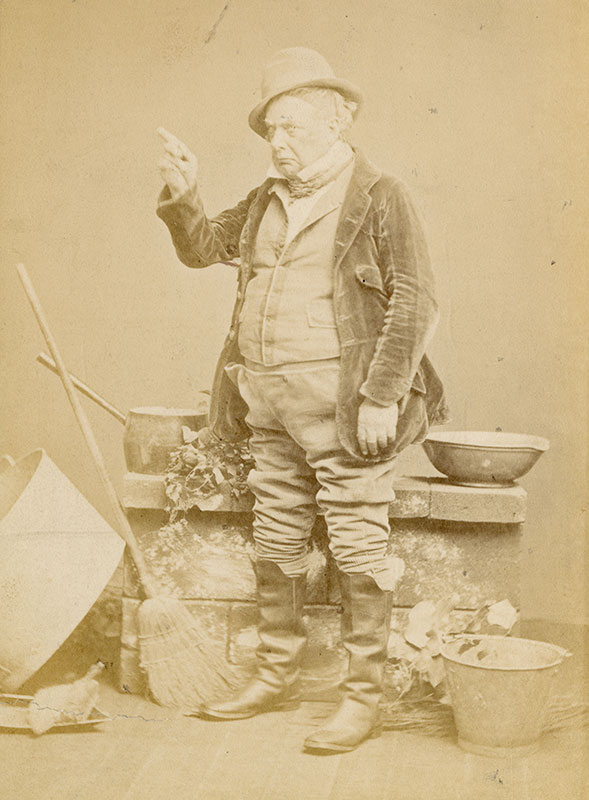
(Picture: George Coppin, in costume as Daniel White in Milky White 1881. Source: RHSV P-440-T)
Born in Sussex in 1819, George grew up with parents who performed as strolling players and went from village to village with various troupes. He would make his stage debut as an infant, playing the part of a baby that was necessary for a scene. He would learn the violin by the age of six, and throughout his childhood would gradually show skill as a comedic actor. By sixteen, his family’s troupe had broken up and he started gaining various theatre jobs, gaining his first stage manager job whilst still a teenager. In 1842, he lived with an older woman in actress Maria Burroughs (with whom he remained in a de-facto relationship until her death in 1848), but with theatre on the decline and travelling circuits closing down, they decided to look elsewhere for future opportunities. Their decision (America or Australia) was decided on a coin toss: Australia won, and they arrived there in 1843.
Throughout the 1840’s, Coppin quickly became a household name on the Australian stage. His crude brand of humour (including his portrayal of the character Billy Barlow) wasn’t for the highbrow, but entertained audiences in Sydney, Tasmania, and Melbourne. He soon settled in South Australia where he opened the first of his theatres: the New Queens Theatre. As a theatre manager he soon became a pivotal figure in Australian theatre as he created friendly relations with the press, strongly advertised whatever or whoever was performing, made sure the right wardrobe was being used, and ensured the plays performed were not only popular with the crowds, but started on time. He is also credited as one of the first in Australia to introduce visiting celebrities on national tours.
Whilst in South Australia, he also owned racehorses, hotels and stock in the copper industry. With the Victoria Gold Rush luring miners away however, he soon found himself in financial trouble and moved back to Victoria in 1851 to win back his fortunes. Whilst he gave up on the goldfields very quickly, George would instead use his theatre experience to pay back his creditors as he ran the Theatre Royal in Geelong, taking advantage of travelling miners by performing for them. He would also appoint an agent to snatch up any new arriving acts for his theatre.
Whilst in England in 1854, he reunited with friend and Irish actor Gustavus V. Brooke, where the two formed a business partnership together. This partnership proved quite lucrative when they arrived in Melbourne. Along with the construction of the Olympic Theatre (a theatre that was prefabricated in England and re-built on the corner of Exhibition and Lonsdale Streets), Coppin and Brooke also owned at various points The Theatre Royal, Astley’s Amphitheatre (later Princess Theatre) and 4 hotels. George would buy the Pleasure Gardens at Cremorne in 1856, which he would not only manage, but also live there for a time.
Around this time, Coppin made his first entry into politics, being elected as a councillor in the municipality of Richmond in 1858, and then narrowly winning a seat in the Legislative Council for the seat of Geelong (which he held until 1863). Whilst a reputable comedian however, he proved surprisingly serious in a political role. As a politician, he supported policies for reforms to suffrage (when only certain members of the elite could vote), to speed up the conveyance of land, cheaper postage and free libraries in country towns.
Alas, juggling politics and his theatrical duties would take its toll, factoring in the break-up of his partnership with Brooke in 1859. In the split, Coppin ended up with Cremorne and the Olympic Theatre, but both were straining his finances. Whilst he would reclaim the Theatre Royal and reunite with Brooke on stage by 1860, he would lose the Royal to a rival, and with a new theatre (The Haymarket) draining most of his income, he was forced to sell Cremorne. To win back his losses, he quit politics and returned to full-time acting (with his multiple ‘retirements’ from the stage, he was the John Farnham of his day) and managed British actor Charles Kean on his tour of America in 1865 (and was in New York when President Abraham Lincoln was assassinated). Even as gout plagued his rotund figure and he made a return to politics, George would continue to perform on stage until late in his life.
But Coppin’s influence on Victoria reached far beyond theatre and politics. A well-known philanthropist, he once donated all his allowance as a politician to charity, and founded or supported many institutions. This included the Victorian Humane Society, the St. Johns Ambulance Association and the Gordon institute of boys. He also was a key founder of the Old Colonists Association, an organisation dedicated to aged care which built its first village at North Fitzroy in 1870.
He is also credited for introducing ice-skating to Melbourne (with lessons held at the Apollo Hall at the Haymarket), was president of the Carlton Football Club (1867-1872), and was able to create a successful copyright business concerning theatrical plays. The latter ensured that theatres would pay a fee to playwrights for the use of their works. He was also influential in the development of the seaside town of Sorrento. There, he invested money in the construction of the Mechanics Institute, The Continental Hotel, and a private tramway service, and had a personal home (known as The Anchorage) built in 1894.
His family life was also filled with drama, and even raised a few eyebrows. After the death of Burroughs, he would be married to Harriet Hillsden (1821-1859), the sister of Brooke’s then wife Marianne. Whilst they had three children together it was tinged in tragedy: one child died before the age of two, and Harriet died days after the third child was born. George would go on to marry his stepdaughter Lucy Hillsden (1841-1920) who he had another seven children with.
After an illness, George died in his home in Richmond on March 14 th 1906. When the Comedy Theatre in Exhibition St was opened in 1939 (on the former site of the Olympic Theatre), a bronze plaque was revealed to honour George’s contribution to Victoria.
BIBLIOGRAPHY/FURTHER READING.
Bagot, Alec, “Coppin the Great”, Melbourne University Press, Carlton, Victoria, 1965.
Colligan, Mimi, ‘Cremorne Gardens, Richmond. And the Modelled Panorama’s 1853-1863’,
Victorian Historical Journal, Vol 66, No. 2, November 1995, p.122-136.
‘Cremorne’, The Bells Life in Victoria and Sporting Chronicle, 1 st January 1859, page 2.
‘Cremorne Gardens’, The Bells Life of Victoria, 13 th November 1858, page 1.
‘Domestic Intelligence’, The Argus, 29 th October 1853, page 5.
‘Grand procession and Fete…’, The Argus, 13 th February 1854, page 5.
Grieg, A.W., The Argus, ‘Cremorne Old Playground of Melbourne’, 30 th April 1910, p.7.
Hall, Alan, ‘First Balloon Ascent In The Australian Colonies’, Royal Historical Society of Victoria, https://www.historyvictoria.org.au/collections-lounge/first-balloon-
ascent-in-the-australian-colonies/
Jackson, Hazelle, ‘Who to Cremorne would not gladly repair’, London Parks and Gardens Trust, http://www.londongardenstrust.org/features/cremorne.htm.
Kumm, Elisabeth, ‘Olympic Theatre’, eMelbourne, http://www.emelbourne.net.au/biogs/EM01089b.htm.
Marsden, Ralph, ‘Melbourne stage-by-stage: Cremorne Gardens and the Pantheon Theatre’, On Stage, Autumn 2006, p.17-19.
Ibid., ‘Melbourne stage-by-stage: The Comedy Theatre’, On Stage, Summer 2005, p.12-15.
Meredith, Louisa Ann, Over the Straits: A visit to Victoria, Chapman and Hall, 1861.
‘Monday, February 9 th 1863’, The Argus, February 9 th 1863, page 5.
My Note Book Volume III from Janurary 2, to June 26 1858, ‘February 6 th 1858’, Volume 3, p.470-472.
O’Neill, Sally, ‘Coppin, George Selth (1819-1906)’, Australian dictionary of biography, Vol.3, 1969, http://adb.anu.edu.au/biography/coppin-george-selth-3260.
‘Opening of the Cremorne Gardens’, The Argus, 3 rd November 1856, page 3.
Otto, Kristin, Yarra: A Diverting History Of Melourne’s Murray River, The Text Publishing House Company, Melbourne, 2005.
‘Prostitution in Melbourne: Public Meeting At The Mechanics Institute’, The Age, 17 th June 1859, p.6.
Rogers, Helene, Brown, Dean & Coppin and Early Ballooning in Australia, Set and Forget Press, Richmond, 1989.
Savill, Barbara J., ‘Cremorne Gardens: A brief History’, Victorian Historical Journal, February 1980, 199 th Issue, Vol. 51, No. 1, p.25-41.
Singleton, John, Maine Liquor Law: Petition to the Honorable the Legislative Council of Victoria in Council assembled, 1853.
South, S. Janet, George Selth Coppin ‘Father of Sorrento’, Nepean Historical Society, Sorento, Victoria, 2004.

 239 A'Beckett Street Melbourne, Victoria, 3000
239 A'Beckett Street Melbourne, Victoria, 3000  03 9326 9288
03 9326 9288  office@historyvictoria.org.au
office@historyvictoria.org.au  Office & Library: Weekdays 9am-5pm
Office & Library: Weekdays 9am-5pm

